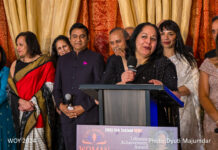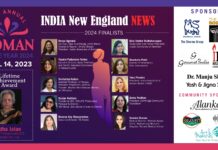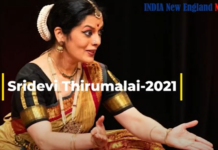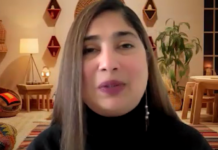 WALTHAM, MA- Gretchen Hayden is the daughter of actor/author/seafarer Sterling Hayden and Betty deNoon Hayden, and credits both for filling her developing years with art, beauty, nature, creativity and original thinking.
WALTHAM, MA- Gretchen Hayden is the daughter of actor/author/seafarer Sterling Hayden and Betty deNoon Hayden, and credits both for filling her developing years with art, beauty, nature, creativity and original thinking.
She is an internationally recognized performer and teacher of kathak dance, and is senior-most disciple of the renowned master and guru, Pandit Chitresh Das. Hayden has dedicated the last twenty-three years to fostering kathak in New England. She and her husband, sarodist George Ruckert, are bearers of tradition, carrying on the legacy of kathak and Hindustani music established in the U.S. and India by Pdt. Das and Ustad Ali Akbar Khan.
Together and with a few others, they initiated the founding of MITHAS (MIT’s Heritage for the Arts of SouthAsia). Their collaborative original works weave tradition into innovative dance solos and dramas, including The Legend of St. Lucy, The Story of Dymphna, and Kore.
Established in 2002, her school Chhandika (Chhandam Institute of Kathak Dance) is a vigorous non-profit organization, offering classes and outreach programs in the greater Boston area. Chhandika’s endeavors also include the training of next generation kathak soloists, teachers and the Chhandika Youth Ensemble. Ms.Hayden has been teaching accredited kathak dance courses at Tufts University and Wellesley College for the past sixteen years, and is a frequent guest lecturer in MIT’s World Music classes.
INDIA New England News: Please tell our readers about your work and what you enjoy most about it?

Gretchen Hayden: Ali Akbar Khan and Chitresh Das settled in the San Francisco Bay Area in the late 60’s and early 70’s respectively. These great artist-masters were the pioneers who planted seeds of their art in the U.S. soil those many years ago. They made sacrifices of their own in order to teach whichever students came before them, day in and day out, throughout the decades following, until their deaths.
I now look back and marvel at whatever forces brought our worlds together. How did a California girl suddenly get swept into the classical Indian kathak universe? And it wasn’t until much later on the path that this was revealed. Today I feel both the weight of responsibility and the gift of being a bearer of the legacy passed to on to us.
It gives me joy to be able to teach students of all ages and variety of backgrounds. I also love the challenge of working with kathak in different, challenging settings. Being on the the dance floor, teaching and seeing students transformed by their own love and deepening appreciation of kathak — this is immensely rewarding. Kathak is one of the powerful and uplifting forces in the 21st century world of art and culture.
INE: To which charitable, community and professional group do you belong and why?
GH: Presently, I am focused on supporting (through (membership or contributions) a myriad of international and national organizations that are work to better the health of the planet: the environment, (clean water, oceans and air, protecting wildlife, sustainable and healthy food-growing practices), along with aid organizations. ACLU. Locally, these include support Rosie’s Place, Big Brother/Big Sister, our town community chest, public library. I am a member of the Boston Dance Alliance, MITHAS, Mass Audubon, as well as a supporter of public radio/TV WGBH and WBUR.
INE: What are your hobbies and interests?
GH: Spending time appreciating the beauty and nature that surround us. During spring and summer, vegetable and herbal gardens are my hobby, along with bird-watching and enjoying the amazing chorus of birdsong music this spring!
INE: In what way do you feel you have positively influenced or served the local community and your company/organization and professional field?
GH: When we moved to this area in the early 1990’s I set my sights on establishing kathak dance, and specifically the teachings of my guruji, in the greater Boston area. And I wanted to bring awareness about kathak to the mainstream dance world, with it being recognized as comparable to classical ballet and other western dance forms. When the time came to establish Chhandika, the intent was to have an organization that would carry this work on well into the future, for generations to come. To that end, I (and Chhhandika) have focused on giving workshops, doing performances, presenting lecture-demonstrations—and throughout all the years, offering quality instruction in kathak for students of all ages and backgrounds. Hundreds of students have been exposed to kathak in Chhandika and through the ivy league university settings (Tufts, Harvard, MIT, Yale, Smith College and others)
As time as gone by. I have been among those sharing this this art within the Indian diaspora. As a westerner who has taken the path of being a kathak artist, I am able to bring a different perspective as I teach students about the value of kathak and other Indian classical art forms.
Tufts University has a very vibrant and intentionally diverse accredited Dance Program. My kathak classes have been a part of their course options for 16 years now. Students can receive arts and cultural credit for taking this course. Being in this setting has enabled me to touch hundreds of university students with Indian classical dance/music and culture.
INE: Your favorite books?
GH: Currently on a close reading shelf:
“A Short History of Everything” by Bill Bryson
“You Are Not So Special” by David McCullough Jr.
“I Know Why the Caged Bird Sings” by Maya Angelou
“Botany of Desire” by Michael Pollan
“Practical Permaculture” by Jessi Bloom and Dave Boehnlein
“Emotional Alchemy” by Tara Bennett-Goleman
“Takuboku: Poems to Eat”
“Polishing the Mirror” by Baba Ram Das
INE: Your favorite quotes?
GH: [I’ve] recently heard “The Universe is under no obligation to make sense to you,” [from] Neil DeGrasse Tyson.
INE: Who inspires you the most?
GH: Deeply inspired by true artists, musicians, dancers, writers, journalists—as well as original thinkers. By those who create beauty. By some of the great spiritual masters, past and present. By school teachers! Scientists. Those with a vision for creating a more harmonious and peaceful world. Those “under the radar” people who give with enduring selflessness generosity, seeking the rewards the work itself, rather than doing for acclaim. Those who are intent on working to create a healthier planet by protecting Nature and improving quality of life. I am in complete awe of those who risk their own lives to save and/or better those of others—from rescue workers, to Doctors without Borders, nurses, aid workers, etc.
INE: Your core value you try to live by?
GH: Someone was quoted as saying “Give with Love to whomever (whatever) God has put in your path” and that has remained in my mind as one profound core value to strive to live by.














